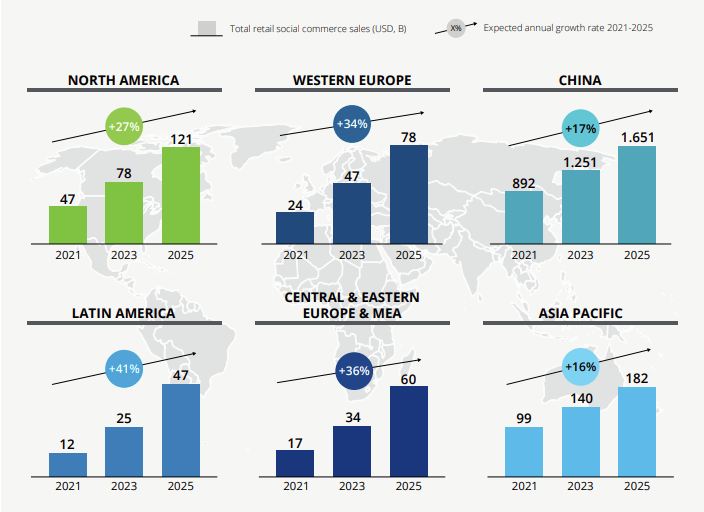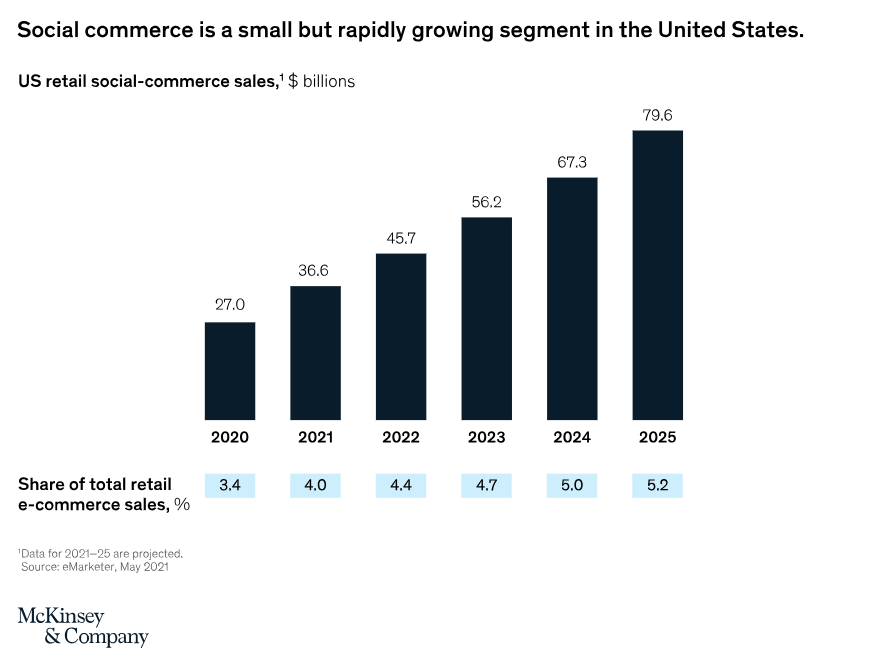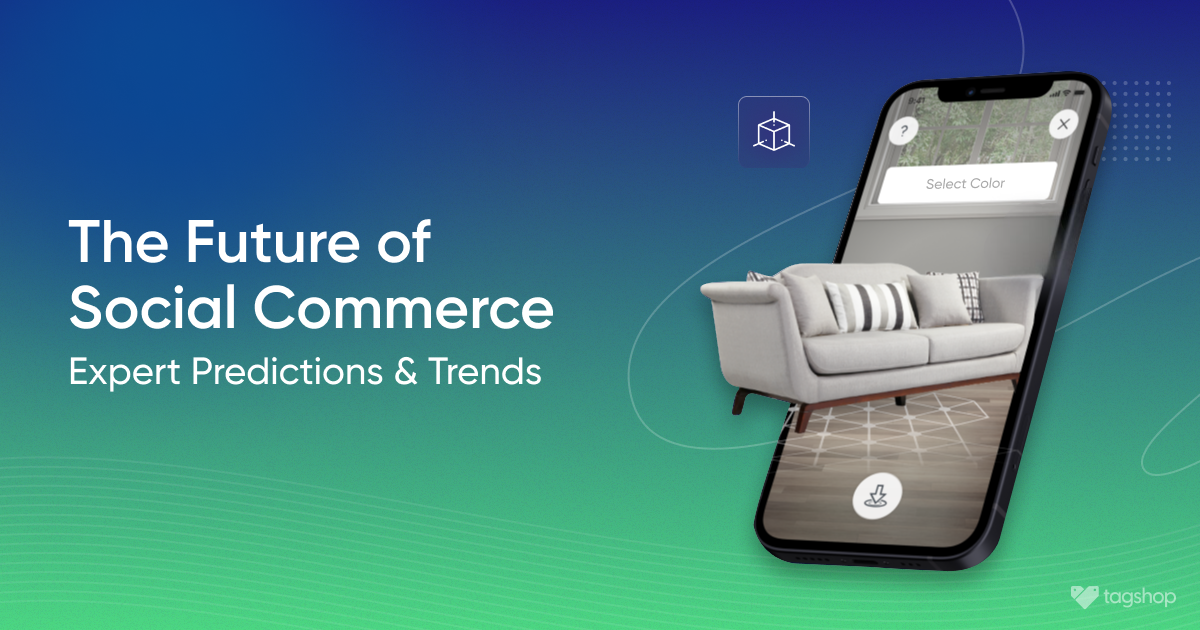The Future of Social Commerce: Expert Predictions & Trends
When there is enough scope for imagination in a subject, interest follows naturally. This is precisely why the subject of e-commerce and its evolution has brought in a palpable boost of excitement to the marketing and business industries.
Such that the e-commerce industry has expanded to give birth to an all-new subset – Social Commerce. The rise of social commerce can be attributed to factors like the popularity of trend-influenced shopping, changes in consumer behavior, and increased reliance on social media for brand discoveries.
Statistically speaking, social commerce will be two trillion USD in the US by 2025. And that’s just the US we’re talking about! The future of social commerce is also booming in other countries and regions, including China as well as European and Asian nations.
Before we jump into future social commerce predictions, let’s first understand its current landscape.
The Current Landscape of Social Commerce

Now that we’re bringing up the current state of social commerce, let’s shed some light on its history and how it started to understand the term better. The term was first coined in 2005 by Yahoo! and was an entirely different concept than it is now. It was simply meant to describe collaborative shopping tools such as user ratings, shared pick lists (wishlists), and other tips around using user-generated content.
In 2024, social commerce is a type of commerce that blends together the social and engaging nature of social media content and the selling/buying capabilities of e-commerce. This strategy is all set to take over the e-commerce space due to its ability to improve a brand’s visibility, trust, and engagement.
In 2022 alone, social commerce generated $53.1 billion in revenue in the U.S., a 34.4% increase over the previous year.
This increase over the years is enough to indicate the beaming future of social commerce, especially for the e-commerce industry.
Which Future Social Commerce Trends Can E-Commerce Businesses Expect?
As we know, by definition, social commerce is a form of commerce that uses ‘social elements’ to buy and sell products. This includes the integration of social media content, mainly user-generated content such as shoppable videos, shoppable images, or shoppable stories to showcase products.

The future of social commerce is poised to be transformative for e-commerce businesses, with several key trends expected to shape the landscape. Let’s delve into specific areas of focus:
1. Live Shopping Experiences
A good customer experience holds immaculate powers for businesses to retain customers. While there are numerous benefits of online shopping, the shopping experience still feels less immersive than retail shopping. Integrating live shopping experiences can minimize this gap and allow customers to engage with brands in real-time, make purchases and further amplify the reach and impact of these experiences.
2. Integration of Augmented Reality
The integration of augmented reality is another future social commerce trend that will entirely change the way people experience shopping online. AR in e-commerce will welcome features like virtual try-ons and an improved product visualization allowing customers to make more informed purchases. This is particularly relevant in e-commerce industries like fashion and beauty, where users need help making buying decisions.
3. Integration of Virtual Reality
Virtual reality is an advanced technology and a future social commerce trend that holds great potential. Businesses may enhance their social commerce strategies even more by integrating virtual reality into their UX, creating virtual shopping environments where customers can navigate through virtual stores, inspect products in detail, and even simulate the physical shopping experience. VR could be particularly impactful for industries such as real estate or home furnishings, allowing users to tour properties or visualize furniture placements in their homes virtually.
4. Blockchain Technology
Another prediction of social commerce future trends includes the rise of blockchain technology that will help e-commerce businesses to instill trust in consumers. Blockchain technology is expected to bring transparency, better phishing detection, security, and traceability to social commerce transactions. This will help customers feel more safe and secure while completing their transactions, leading to more revenue and less cart abandonment.
5. AI-Powered Customer Support
Artificial intelligence has proved to be of great value as a customer support tool in the e-commerce sector. AI voice assisting and AI chatbot functionalities have really helped businesses. In the near future, this feature can expect the continued integration of AI-powered chatbots and virtual assistants to provide real-time support, answer customer queries, and offer personalized recommendations.
As social commerce continues to grow and evolve, these trends are set to enhance this strategy even more, allowing e-commerce businesses to improve the shopping experience in a way that generates direct profit.
However, even among these trends, the integration of augmented reality and virtual reality in social commerce stands out as the supreme strategy.
Let’s learn more about them.
Integration of AR & VR in Social Commerce
The scope of any novel technology is defined by three important factors:
- It’s practical to use.
- If there is an existing demand in the market.
- The problem it is solving.
When we talk about augmented reality and virtual reality in social commerce, it majorly ticks off all these points. AR & VR are already existing technologies that various industries are already using and are leveraging to achieve great value.
Now, we shall talk about both the technologies in detail.
AR in Social Commerce
The future of social commerce is filled with exciting technologies, and one of them is augmented reality. According to research by Deloitte, 60% of the global shoppers (and 50% in Europe) are interested in Augmented Reality driven shopping experiences.
It’s because AR enables users to visualize products in real-world settings through their devices. In social commerce, this translates to features like virtual try-ons for apparel and consumer goods industries, allowing users to see how products look on themselves before making a purchase.
VR in Social Commerce
When it comes to virtual reality, the retail world is already making big advancements by allowing customers to visualize products as realistically as it could get. Statistically, The global virtual reality market is projected to reach $87 billion by 2030.
Similar to AR, VR can offer advanced virtual try-before-you-buy experiences. Users can create lifelike avatars to try on clothing or accessories, providing a highly immersive and personalized shopping experience. This highly immersive shopping experience can help e-commerce businesses stand out from the competition and showcase their offerings in a more dynamic way.
The integration of Augmented Reality and Virtual Reality in social commerce enhances the overall shopping experience by providing interactive, immersive, and personalized features. These technologies have the potential to revolutionize how users discover, engage with, and purchase products in the evolving landscape of online commerce.
Rise of Social Commerce & Top Social Commerce Platforms

The rise of social commerce represents a transformative shift in the way people engage with online shopping. Here are a few emerging social commerce platforms that are super aligned with the scope of social commerce in the nearing future.
1. Yotpo
Yotop is a top social commerce platform that stands out in the wide arena of social commerce by providing unique shoppable features. Focused on visual marketing content like images, videos, tagged pictures and stories, Yotpo enhances brand credibility by providing a platform for businesses to boost their sales, improve brand identity and establish trust by integrating this visual content into their e-commerce touchpoints.
2. Pixlee TurnTo
Pixlee TurnTo is a key player in the social commerce landscape and e-commerce integration. Specializing in seamlessly leveraging user-generated photos, Pixlee empowers brands to drive engagement and boost sales by incorporating authentic visual content into their online presence and allowing consumers to shop from the content directly.
3. Tagshop
Tagshop is a top social commerce platform meant especially for e-commerce businesses looking to scale their growth through authentic and engaging social content. The platform has the ability to collect and curate social media content and turn it into captivating shoppable galleries. With Tagshop, brands can integrate their shoppable galleries into touchpoints like emails, home page and product pages. That’s not all. Tagshop also allows its users to create a shoppable link in bio to direct their audience on social media to their e-commerce website.
4. Bazaarvoice
Bazaarvoice is a leading social commerce platform that provides functionalities like shop the look, shoppable social galleries and reviews and ratings. There is no feature that Bazaarvoice doesn’t provide. It is truly a full suite of social commerce and provides e-commerce businesses with the opportunity to enhance their credibility, improve revenue and establish trust through social content.
5. Sauce
Sauce is another popular social commerce platform that claims to enhance buyers’ journey significantly. This tool is recognized for its live shopping capabilities, enabling brands to sell products through social content in real-time. This dynamic platform allows for direct engagement with audiences, creating an interactive and immersive experience that goes beyond traditional online shopping.
Even though social commerce is already one of the highest yielding strategies for e-commerce businesses, the future of social commerce highly depends on what the market is able to provide to businesses looking to scale this strategy.
These above mentioned platforms are providing some of the most impressive features to e-commerce businesses. Reportedly, over thousands of businesses have agreed that they use social commerce platforms to enhance and accomplish their strategies.
Cross-Channel and Omnichannel Social Commerce Strategies
By definition, cross-channel and omnichannel social commerce strategies involve leveraging multiple social media platforms both, individually and altogether, to reach a diverse audience and generate brand exposure to its maximum.
With these strategies in the picture, brands can implement cohesive marketing strategies across different channels, tailoring content and campaigns to suit the unique characteristics of each platform.

For example, a brand may use Instagram content and integrate it into its website’s product pages to showcase products appealingly. Along with that, brands can use the same content to other channels such as for email marketing and generate more clicks and revenue from there. The key is to maintain a consistent brand identity while adapting to the specific strengths and user behaviors of each channel.
Here are some cross-channel and omnichannel strategies:
- Hosting Tailored Campaigns: Launch tailored marketing campaigns that suit the characteristics of each channel. For instance, use visually appealing content for Instagram and concise messages for Twitter.
- Start Promotions On Relatable Channels: Implement cross-promotions where customers on one channel are encouraged to explore and engage with the brand on another. Offer exclusive deals or content accessible through specific channels.
- Include Social Media Integrations: Integrate e-commerce functionalities directly into social media platforms, allowing users to discover and purchase products without leaving the social environment.
- Multi-Channel Advertising: Utilize various advertising channels, such as social media ads, search engine marketing, and display advertising, to reach a broader audience and reinforce brand presence.
- Email Marketing Campaigns: Coordinate email marketing efforts across channels. Ensure consistency in messaging and timing to make sure customers have enough communications.
- Mobile Optimization: Optimize content and user experiences for mobile devices. Many customers switch between devices during their purchase journey, and a mobile-friendly approach is crucial.
Ending Note
The future of social commerce holds exciting possibilities for e-commerce businesses as it is the only strategy that deeply uplifts businesses irrespective of their size and niche. Social commerce allows businesses to integrate their efforts on social media and showcase it to a wider audience.
Additionally, advancements like AR and VR in social commerce are other exciting features that push this strategy to become the best plan for e-commerce businesses. Several trends and developments are likely to shape the landscape of social commerce in the coming years.
Be a Pioneer in E-Commerce Evolution!
Click to Discover the Future of Social Commerce Trends.
Book A Free TrialFrequently Asked Questions:
What are the key trends expected in social commerce over the next five years?
Anticipated trends include the continued integration of augmented reality, virtual reality), the rise of live shopping experiences, increased personalization through advanced AI, more inclusion of user-generated content and the growth of social commerce on emerging platforms.
How will augmented reality (AR) impact social commerce in the coming years?
AR is set to significantly impact social commerce by offering features like virtual try-ons for enhanced product visualization. This technology will create interactive product demonstrations,, and shape immersive shopping experiences.
Are there emerging social media platforms that will play a significant role in social commerce?
Social media platforms that are more visually-centric have a better chance of playing a more significant role in the social commerce realm. A few examples of these platforms can be Instagram, TikTok, or Pinterest.
How can e-commerce businesses prepare for the integration of virtual reality (VR) in social commerce?
E-commerce businesses preparing for VR integration in social commerce can focus on adopting VR-friendly product visualization, creating virtual shopping environments, and staying updated on VR technology advancements to seamlessly incorporate them into the customer journey.
Will AI-powered recommendations become a standard in social commerce?
Yes, AI will become a standard in social commerce due to its ability to pose as a virtual assistant. Businesses will be able to use AI-powered assistants for customer support and help businesses resolve customer queries instantly.










